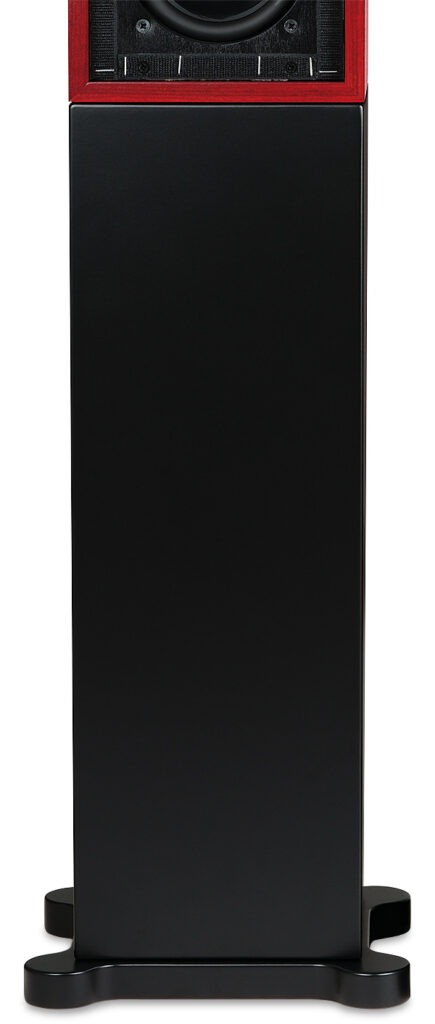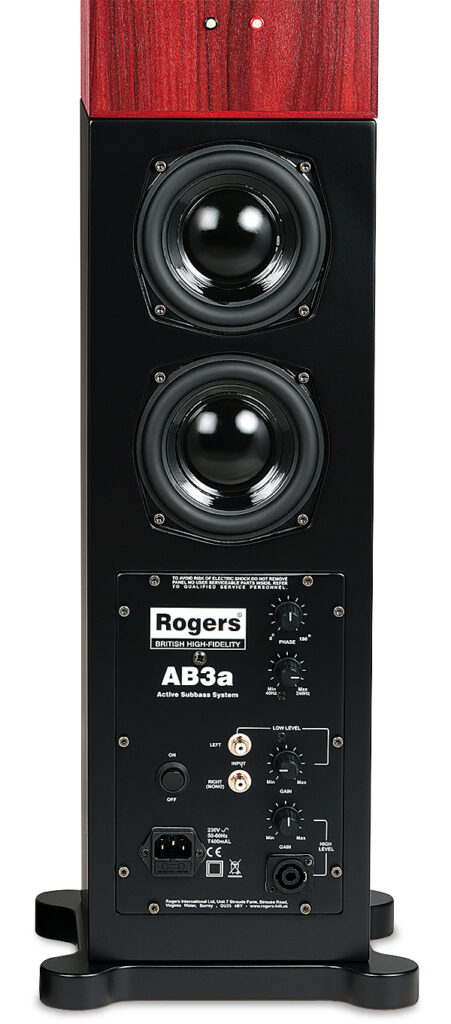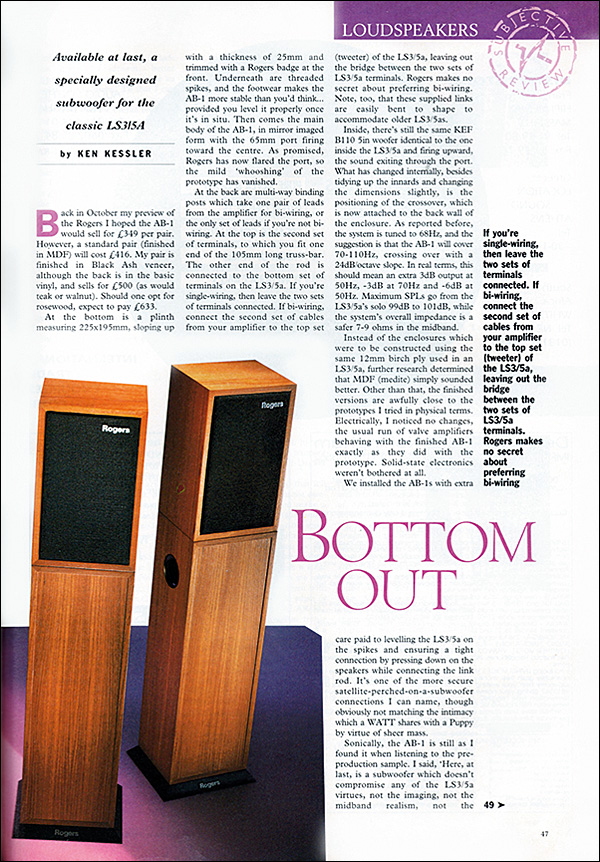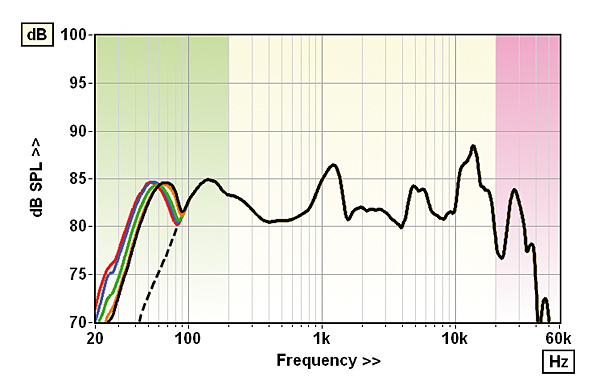Rogers AB3a Subwoofer Hi-Fi News UK Review
Review: Ken Kessler, Lab: Paul Miller | Nov 24, 2021


Since its birth, devotees of the LS3/5A have craved more bass – does the answer lie in Rogers’ active AB3a sub?
Delayed because of the pandemic, Rogers’ AB3a subwoofer is one year off being able to claim it’s the 25th anniversary celebration of its passive predecessor, 1995’s AB1. Yes, the gap between them has been that long. The postponement doesn’t, however, diminish the delight LS3/5A users will show for the arrival of a dedicated active subwoofer for one of the most celebrated small monitors in the history of hi-fi. It’s here, and it’s a honey.
Given that current Rogers or Falcon Acoustics LS3/5As [HFN Jul ’19 and Dec ’18] sell for circa-£2500 per pair depending on finish, while vintage LS3/5As can fetch as high as £10,000-£15,000 if you’re either obscenely profligate or certifiably insane, the £3499-per-pair sticker price of the AB3a will hardly cause outrage. What’s decided for you is the finish: as standard it’s only offered in satin black, a colour which works with whatever LS3/5A you perch on top. Rogers will, though, finish a pair any way you like for an added stipend.
Double Bass
What you get are sized exactly like the AB3a’s quarter-century-old antecedent, but the rear-firing driver count has doubled, each cabinet now hosts a 50W amplifier, and the look is vastly more refined. The slick cabinet just happens to raise the LS3/5A to what I’ve always found to be the perfect height, so in situ, each AB3a-plus-LS3/5A stands 3ft/920mm tall, give or take a few millimetres depending on how you adjust the spikes.

Contrary to discussing these vis-à-vis LS3/5As, it’s worth pointing out that Rogers describes these 2ft-tall units as ‘specifically designed for use with the LS3/5A or similar small monitors’. It’s a claim supported by the AB3a’s super-flexible adjustments, which I’ll get to in a moment.
At the back of each AB3a, beneath a Tygan grille held in place magnetically, are two woofers like the ‘re-imagined’ B110s in Rogers’ current LS3/5As. The enclosure is sealed, whereas the original AB1 was ported. Below the woofers can be found four rotaries for adjusting the phase (0° -180° ), high- and low-level gain and low-pass filter frequency (40Hz-240Hz).
These steps are undertaken by ear, but the manual is lucid, so the listener is guided into setting each for peak performance. With judicious listening, some music with clean, rich bass, and a friend to fiddle with the knobs while you sit in the hot seat, you can optimise the low-frequency alignment for ideal room placement. I was lucky as they worked perfectly exactly where I place almost all small, stand-mounted two-way speakers in my room, which happens to be my preferred spot for LS3/5As.
Connections are a different matter. The best set-up for this employs the ‘two pairs of leads from one set of terminals’ reminiscent of bi-wiring. One goes to the AB3a, connecting via a professional Speakon plug, supplied with the AB3a and 5m of cable. The other, user-provided leads go to the LS3/5A (or other small speaker) from the same set of terminals.
Alternatively, there are also phono inputs to feed the AB3a from a sub or preamp output. This connects to the low-level input, while the Speakon feeds the high-level input. Nevertheless, feeding the LS3/5A and sub from your main amp output remains the preferred method. Niggles? As the on/off rocker is on the back, how about a tiny blue pilot light on the front, at the base, so you know they’re switched on?
![]() Fire Down Below
Fire Down Below
Feeling mischievous, I turned the AB3as around, the drivers firing at me. And stone me if they didn’t sound amazing with a volte face. I accept, though, that this is not advised, but, hey, try and stop me. I’m glad I did. Having said that, for this review the subwoofers were auditioned as designated: rear-facing drivers and with current-production LS3/5A loudspeakers.
Although these are LS3/5A-centric, I used them with both Tannoy’s Autograph Mini and JBL’s 4321M small monitor to test Rogers’ claim of compatibility with other speakers. So, stone me again – thanks to the adjustable gain, phase and LPF settings, you can, indeed, use the AB3a with other small loudspeakers.
Free ‘N’ Easy
If you are hoping that the AB3a will enable LS3/5As to 1) bang out Twisted Sister at 120dB, and 2) play Kodo drums with the same impact as via a quartet of 18in Hartley woofers, then you’re in for a huge disappointment. On the other hand, if ‘subtlety’ is a virtue in your estimation, then the changes wrought by the AB3a will impress.
First, you must forget the AB1 ever existed. While I still get a kick out of mine, the AB3a is to the AB1 what a 4k OLED screen is to a 405-line black-and-white cathode-ray TV. The AB3a is everything you want from an active subwoofer bar the ability to loosen your home’s foundations. It is not a kick-you-in-the-gut device for adding thrills to a home cinema.
Rather, you need to approach the AB3a expecting to free up the sound, if in ways that do not immediately spring to mind. Call them unintended consequences or, better still, unanticipated benefits. And what first made me realise this was the Nimbus Supercut of Miles Davis’ Kind Of Blue [CBS 62066]. The difference between with AB3a and without revealed itself throughout the entire LP, in various ways. The first was a sense of greater openness, the second was enhanced stage depth, while a third benefit was the exposure of fine details with improved clarity.
As this LP is a trumpeter’s creation, you’ll be pleased to learn that the punch, extension, clarity and, yes, the sound of Miles’ saliva, were a touch more vivid. Please bear in mind that the subwoofers were tuned to their least intrusive settings, such that I was wondering if they were even switched on. I couldn’t see or feel any woofer movement when I removed the grilles from the AB3as to check.
Up Scale
To reassure myself, I cranked up the level just enough to hear an audible blub-blub-blub, so, yes, they were working. In my system, the crossover was set around 60-80Hz, phase to –60° and level two notches from the minimum (after having dialled in too much level just to hear them working).

Moving on to my definitive bass tester, The Band’s eponymous second LP [Mobile Fidelity MFSL 1-419], the dry percussion from ‘Up On Cripple Creek’ gets me every time, along with the copious, melodic bass. But I repeat, without employing exaggerated level settings, the sound was distinctly more substantial. There’s a snap to Levon Helm’s drumming which is truly inimitable, while the entire song – no, make that the entire LP – has a richness that has always characterised The Band’s sound.
It’s a manifestation of the texture or atmosphere that you find in rural or unplugged blues recordings, including early Muddy Waters or Lightnin’ Hopkins, and it’s what modern roots music devotees aspire to for authenticity. You get a taste of it with LS3/5As on their own, while always suspecting that there’s more waiting in the wings. Switch on the AB3a and it augments an LS3/5A au naturel (and the wee Tannoy) with just enough extra weight and warmth to expand the room-filling capability of the sound, with a discernible increase in scale.
Rising Stars
Two sublimely recorded, inherently warm albums such as The Band and Kind Of Blue are already in possession of a rich, reinforced bass, so I dug out something more bright and treble-oriented, though of equally sublime recording quality. Herb Alpert’s open-reel tapes are exceptionally well-recorded (he owns his record label – doh!), and I couldn’t resist a burst of The Beat Of The Brass [A&M AMC146], with its corny, staccato interpretation of The Mamas And Papas’ 1961 hit song ‘Monday Monday’.
Normally, such kitsch makes me wanna hurl, but I’ve warmed to it since owning it on reel-to-reel tape. Here the AB3a revealed another of its deft abilities by shifting the emphasis away from all the treble activity to the band’s rhythm section. Again, the effect was subtle, but it was like adjusting the seasoning in a complex dish. The Rogers AB3a, then, is like another twist of the pepper mill, a scant hint of thyme. And that might be the difference between two Michelin stars… and three.
Hi-Fi News Verdict
When I raved about the AB1, I took a lot of stick for being too easy on it. That won’t apply to the AB3a because it is what you make of it, thanks to the range of adjustments. I won’t say the AB3a obviates the use of LS3/5As on their own, but they certainly augment bass and SPLs without affecting the purity of what’s on top. This is one clever subwoofer: it does what it says on the box and looks great to boot.
Memory Lane
If you don’t own the April 1996 issue of HFN, let me summarise our review of Rogers’ original AB1 subwoofer [inset here]. A key difference lies in the enclosure material – the AB1 prototypes used birch ply, but production models were made of Medite, Rogers arguing that MDF ‘simply sounded better’. As many are now learning thanks to cancel culture, what was OK in the past no longer applies, so the new AB3a reverts to the wood of the AB1 prototype and the LS3/5A itself.

With only one B110 woofer, a passive crossover and no electronics, AB1s were far simpler beasts, devoid of adjustability. You simply inserted them in place of the stands you were using. Amusingly, even if you didn’t wire them in, AB1s actually made decent, complementary supports, especially if you weighed down the speaker sitting on top with ‘bricks’ such as the VPI or the HFN Flux Dumper. You could wire the LS3/5As off links from the AB1s, which were driven by the amp, or you could bi-wire them. And the sound? A bit ‘one-note’, but a tad louder and deeper, and for many of us, that was enough.
Lab Report
Tested with the latest 15ohm LS3/5A, also from Rogers, the sheer ‘adjustability’, and placement scenarios, of the AB3a provokes a baffling array of possible response combinations. As a result, I will focus on the corrected, nearfield (free space) performance of this combination. The LS3/5A’s 110mm Bextrene bass/mid unit is tuned with a ~5dB uplift at 143Hz (effective bandwidth is 75Hz-334Hz, –6dB) followed by a 2nd-order roll-off which, when used as a satellite, endows this little speaker with a limited 75Hz bass extension (–6dB re. 200Hz). However, when optimally integrated with the AB3a subwoofer, this takes the system down to 38Hz regardless of the 40Hz-240Hz low-pass setting.
That’s the headline figure – the detail is at the mercy of LPF, phase and gain (level). For example with the LPF set to 80Hz, and positive (0o) absolute phase, the on-axis –6dB bandbass is 32Hz-86Hz (55Hz peak). In practice, increasing the low pass corner frequency from 40Hz all the way up to 240Hz results in a shift in the AB3a’s tuned frequency from 52Hz up to 67Hz and the working bandpass from 32Hz-85Hz to 40Hz-111Hz (all re. –6dB). As important is the progressive +6dB uplift in output across the span of these LPF settings [see Graph 1 – 240Hz, black; 180Hz, orange; 120Hz, green; 80Hz, blue; 40Hz, red]. The dashed black trace is the same measurement taken in a corner location at the widest 240Hz LPF setting. The peaks and dips seen here centred around 40Hz, 50Hz, 65Hz are cancellations and reinforcements that will vary in frequency and amplitude according to distance.
Correcting for level and merging the nearfield outputs of the LS3/5A and the AB3a reveals a –3.5dB dip at 90Hz [Graph 2]. In practice, this could be ameliorated by boundary placement and tuning of the phase control. In theory, with the same turnover frequencies (not exactly so here), then we naturally end up with a +90° phase shift at crossover from the LS3/5A’s 2nd-order roll-off and –90° from the sub. This yields 180° and a dip in the overall response. The solution is to steadily invert the polarity of the AB3a’s output to ‘fill-in’ the dip at 90Hz. Good luck! PM


| Pair matching (30Hz–130Hz) | +0.5dB |
| LF extension (–6dB ref 200Hz) | 38Hz (with LS3/5A) |
| THD 40Hz/100Hz (for 85dB SPL/1m) | 1.5% / 0.8% |
| Dimensions (HWD) / Weight (each) | 600x190x165mm / 11kg |
| Price (pair): £3499 (RAL colours to order) |
0 Comments